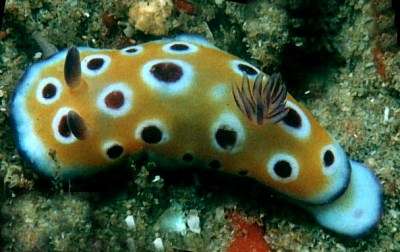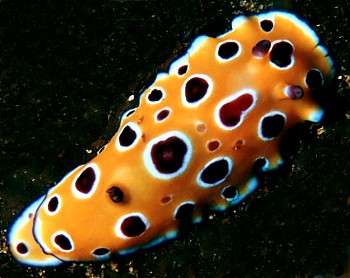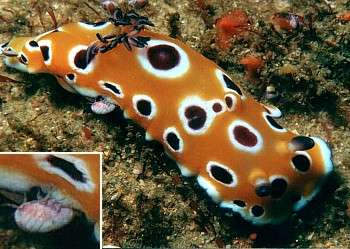
Chromodoris cf. geminus
Order: NUDIBRANCHIA
Suborder: DORIDINA
Superfamily: EUDORIDOIDEA
Family: Chromodorididae
PHOTO
South Coast of KwaZulu/Natal, SOUTH AFRICA, Near Port Shepstone. Rocky Reef, 20 - 25m, October 1999. Size: 40mm. PHOTO: Valda Fraser.
Note added 4 May 2007: This animal is most probably an extreme colour form of Chromodoris cavae - see message #19876.
This looks quite like Chromodoris geminus which has also been reported from South Africa. However it is deeper in colour than the C. geminus and differs in having the purple right at the mantle edge rather than submarginally. There is also a distinct deep yellow submarginal band in C. geminus while in C. cf. geminus the yellow-brown background colour on the mantle is uniform. Also in C. geminus there are spots on the foot and a white edge, while in this species there are spots on the foot but it has a purple edge. The rhinophore clubs are purple not yellowish. This may be a mimic of C. geminus.
A very distinctive behavioural characteristic of C. geminus, which you can see in the photo at the top of the C. geminus page, is that the mantle edge is raised and lowered in one movement all around the mantle edge. Valda Fraser's message shows that this species differs in having the more usual waves of movement down each side of the mantle.
Authorship detailsRudman, W.B., 1999 (December 1) Chromodoris cf. geminus [In] Sea Slug Forum. Australian Museum, Sydney. Available from http://www.seaslugforum.net/find/chrocfge
Related messages
Chromodoris cf. geminus from Mauritius
November 21, 2002
From: Marina Poddubetskaia

Dear Bill,
Can you help me to identify this Chromodoris from Mauritius, please?
It is different from Ch. geminus , Ch. kuniei and Ch. leopardus because it hasn’t any blue border on the mantle. But apart from this lack of the blue border it looks like your Chromodoris cf. geminus.
Pereybere, Mauritius, Indian Ocean. Site: L'aquarium de Pereybere. Depth: 10m. Size: about 40mm. October 15, 2002. Photos: Marina Poddubetskaia - Nembro website
Best wishes,
Marina.
nembro@nembro.info


Thanks Marina,
Despite the lack of a bluish border I am sure this is what I am calling Chromodoris cf. geminus on the Forum. Your ventral photo shows the nature of the mantle glands very well,
Best wishes,
Bill Rudman
Re: Movement in Chromodoris cf.geminus
June 3, 2002
From: Lindsay Warren

Dear Bill
Here's an answer to an old question. I have just been going through my notes on specimens found and photographed while diving with Valda Fraser last December. The C. cf geminus Valda found at the time flapped its anterior mantle like C. geometrica when moving but not the entire length of it as in C. kuniei. I have attached a photo of mine showing the anterior mantle partly raised revealing oral tentacles, etc. Hope this is of help. Photo: Lindsay Warren.
All the best
Lindsay
alldcl@compuserve.com
Warren, L., 2002 (Jun 3) Re: Movement in Chromodoris cf.geminus. [Message in] Sea Slug Forum. Australian Museum, Sydney. Available from http://www.seaslugforum.net/find/7103Thanks Lindsay,
I'm glad to say there is no time limit on answering questions.
Best wishes,
Bill Rudman
Movement in Chromodoris cf. geminus
December 2, 1999
From: Valda Fraser

Dear Bill
You asked me to take note as regards how Chromodoris cf. geminus moves. Hopefully this photo provides visual illustration. I don't see that "the mantle edge is raised and lowered in one movement"... It just seems to "pleat" irregularly?! I have good video footage, but getting it to you is a problem.
Locality: South Coast KwaZulu-Natal, SOUTH AFRICA. Scottburgh - rocky reef - 24m., November 1999. Size: 75mm
Regards
Valda Fraser
iti04937@mweb.co.za
Fraser, V., 1999 (Dec 2) Movement in Chromodoris cf. geminus. [Message in] Sea Slug Forum. Australian Museum, Sydney. Available from http://www.seaslugforum.net/find/1595Dear Valda,
It certainly looks like your animal is a different species. As I said earlier, C. geminus, has a very distinctive way of flapping the edge of the mantle so that the whole of the edge rises simultaneously then is lowered, then rises etc etc, in a spectacular rhythmic display. Your animal seems to be sending an irregular 'ripple' down each side of the mantle in a fairly normal chromodorid movement. I have moved this species to a separate page and for convenience will call it Chromodoris cf. geminus, the 'cf' being our shorthand for 'refer to'.
Thanks for the information,
Bill Rudman.
Re: Chromodoris geminus? from Sth Africa
November 14, 1999
From: Valda Fraser


Dear Bill
Thanks for your reply. Unfortunately I don't have a really good photo of the animal's foot. I know that there are a few spots, but I don't remember how many. I also know that the spots match the body perfectly. I will send you a decent photo as soon as I can.
I clearly see the link between C. geminus and the nudibranch which I have photographed. However it's the body profile that doesn't compare well. C. geminus looks flat. Only small specimens of our C. geminus? are flat. They soon become plump and rounded. Hopefully the photos illustrate this observation adequately.
Locality: South Coast KwaZulu/Natal - SOUTH AFRICA. Near Port Shepstone, rocky reef, 20 - 25m., October 1999. Size: 30mm and 70mm
Regards
Valda Fraser
iti04937@mweb.co.za
Fraser, V., 1999 (Nov 14) Re: Chromodoris geminus? from Sth Africa. [Message in] Sea Slug Forum. Australian Museum, Sydney. Available from http://www.seaslugforum.net/find/1520Dear Valda,
Thanks for the extra photos. Yes the spots on the foot are like those on C. geminus but the purple border is clearly different. The shape of adults is a bit more difficult to interpret as in 'typical' C. geminus the mantle edge flaps up and down giving the animal a flat appearance when the mantle edge is held horizontal. Can you remember if your animals flap the mantle like this?
Probably it will only be resolved when the anatomy is studied.
I noticed two amphipod crustaceans on the large animal (see inset). Have you noticed these on other nudibranchs in the area? Perhaps they are commensals?
Best wishes,
Bill Rudman.
Chromodoris geminus? from South Africa
November 11, 1999
From: Valda Fraser

Dear Bill
This nudibranch occurs quite commonly in our area. When it is small its body profile is very flat. However, as it grows the body becomes much more raised. Smaller specimens are less bright in colour. The colour of the animal becomes increasingly rich with age. I am sending you an image of a half grown one, The big ones are troublesome to me, as they do not fit into my 70mm framer.
Locality: South Coast KwaZulu/Natal - SOUTH AFRICA, Near Port Shepstone
Rocky Reef, 20 - 25m, October 1999
Size: 40mm
Regards
Valda Fraser
iti04937@mweb.co.za
Fraser, V., 1999 (Nov 11) Chromodoris geminus? from South Africa. [Message in] Sea Slug Forum. Australian Museum, Sydney. Available from http://www.seaslugforum.net/find/1516Dear Valda,
This looks quite like Chromodoris geminus which I described from Tanzania in 1987. Terry Gosliner has also reported C. geminus from South Africa (Chromodoris sp. 3. in his book), but I am not at all sure that your animal is the same.
It's a little bit deeper in colour than the C. geminus and differs in having the purple right at the mantle edge rather than submarginally. There is also a distinct deep yellow submarginal band in C. geminus while in your South African animals the yellow-brown background colour on the mantle is uniform. Also in C. geminus there are spots on the foot and a white edge, while in your animal I can't see if there are any spots on the foot but it has a purple edge. The rhinophore clubs in your animal are purple not yellowish. All in all I think this may be a mimic of C. geminus.
A very distinctive behavioural chracteristic of C. geminus which you can see in the photo at the top of the page is that the mantle edge is raised and lowered in one movement all around the mantle edge. Does your animal do that? C. kuniei from the western Pacific also flaps its mantle like this.
Your photos are very useful. The more photos we can get of species throughout their geographic range, the more chance we have of understanding the limits of a species' geographic distribution and colour variation. If you have photos which show the foot and mantle edge more clearly they could be useful.
Best wishes,
Bill Rudman.
